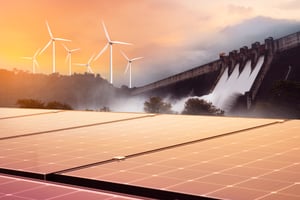Investor-owned utilities (IOUs) are encountering a growing threat from physical climate risks,...
What the US Solar Boom Means for the Future of Energy
The recent surge in utility-scale solar deployments in the United States, marked by a 107% year-over-year increase in the third quarter of 2023, is more than just a statistic; it's a testament to a burgeoning renewable revolution. This unprecedented growth in solar energy capacity, particularly at the utility scale, is reshaping the future of energy in the U.S. and has broader implications globally.
The Scale of Growth and Its Implications
The U.S. solar industry connected 4.1 gigawatts (GW) of utility-scale solar to the grid in just three months of 2023, compared to 1.9 GW in the same period last year. This leap is a significant milestone in the nation's energy transition journey. It reflects the collective drive towards cleaner, more sustainable energy sources, spurred by growing environmental concerns and bolstered by supportive government policies like the Inflation Reduction Act.
Driving Forces Behind the Boom
The rapid growth of solar energy in the United States can be attributed to several pivotal factors that have collectively propelled its expansion. Foremost among these is the proactive role of the U.S. government in advancing renewable energy adoption. The government has played a crucial role in incentivizing solar energy investment and development through incentives, subsidies, and supportive legislation, such as the Inflation Reduction Act.
Technological advancements in the solar energy sector have been instrumental as well. Ongoing enhancements in solar panel efficiency and the availability of more cost-effective energy storage solutions have significantly increased the competitiveness of solar power compared to traditional energy sources. These technological strides have not only boosted the reliability of solar energy but also made it more accessible and appealing to a broader spectrum of consumers.
Furthermore, the economic viability of solar energy has been a compelling driver of its growth. The decreasing cost of solar installations, coupled with the rising costs associated with fossil fuels, has rendered solar energy a financially attractive option for both energy providers and consumers. This cost-effectiveness translates into savings and fosters adopting renewable energy on a larger scale.
Additionally, the growing environmental awareness surrounding climate change and the ecological consequences of continued reliance on fossil fuels have propelled solar energy into the limelight. Individuals and corporations increasingly recognize the necessity of transitioning to cleaner energy sources. As a result, there is a mounting commitment to investing in and supporting solar energy initiatives as part of a broader effort to mitigate environmental impacts and promote sustainability. Collectively, these factors have fueled the remarkable growth trajectory of solar energy in the United States.
Impact on the Energy Landscape
The solar boom profoundly reshapes the U.S. energy landscape in several crucial ways. First, it plays a pivotal role in diversifying the nation's energy sources. By harnessing solar energy, the U.S. is reducing its reliance on fossil fuels, enhancing energy security, and aligning with sustainability goals. Furthermore, the integration of large-scale solar projects is driving the modernization of the electrical grid. This modernization equips the grid with the capability to handle variable renewable energy sources more efficiently, making it more resilient.
In addition to these transformative effects, the solar industry has a notable economic impact. It is not only creating jobs but also acting as a catalyst for economic growth. Furthermore, the flourishing solar sector presents new opportunities for innovation and attracting investment, positioning itself as a crucial driver of economic prosperity.
One of the most compelling outcomes of increased solar energy utilization is the substantial reduction in greenhouse gas emissions. The eco-friendly attributes of solar energy contribute significantly to the ongoing battle against climate change. As solar power gains prominence in the energy landscape, reducing emissions bolsters efforts to combat the global environmental challenge of excessive greenhouse gases.
Challenges and Solutions in the U.S. Solar Boom: A Focus on AI-Enhanced Strategies
As the United States witnesses an unprecedented surge in utility-scale solar deployments, it's crucial to address the inherent challenges this growth brings. AI and advanced technologies play a pivotal role in navigating these challenges and ensuring the sustainable expansion of solar energy.
Addressing Supply Chain Constraints with AI
Embracing predictive analytics powered by artificial intelligence (AI) holds immense potential for bolstering supply chain management within the solar energy industry. Through the analysis of data trends, AI can provide invaluable insights into supply chain dynamics, enabling the forecasting of supply needs with a high degree of accuracy. Furthermore, AI-equipped systems can proactively identify potential disruptions from unforeseen events or logistical challenges, allowing for timely mitigation measures. In the face of global supply chain volatilities, AI can recommend alternative suppliers or materials, providing a crucial buffer against interruptions and ensuring the seamless flow of resources critical to solar energy projects.
Moreover, optimizing manufacturing processes for solar panels is another domain where AI demonstrates its prowess. By leveraging machine learning algorithms, AI can significantly streamline and enhance the efficiency of solar panel production. These algorithms can optimize production schedules, ensuring manufacturing operates at peak productivity while maintaining stringent quality control standards. Additionally, AI can contribute to predictive maintenance, anticipating when equipment may require servicing or replacement, thereby reducing downtime and minimizing production disruptions. AI-driven optimization effectively translates into cost savings, increased output, and enhanced solar panel manufacturing sector competitiveness.
Tackling the Intermittency of Solar Power
A multifaceted approach involving AI is proving instrumental in addressing the intermittent nature of solar power. AI plays a pivotal role in various aspects of the solar energy landscape, helping to enhance reliability and efficiency.
In the realm of energy forecasting, AI models are of paramount importance. Accurate predictions of solar energy production are vital for balancing supply and demand. Leveraging weather data, historical energy production patterns, and real-time grid conditions, AI models provide precise forecasts of solar energy generation. This capability empowers grid operators to make informed decisions, effectively managing fluctuations in energy output.
Additionally, AI is optimizing the integration of energy storage solutions. AI algorithms intelligently predict energy demand peaks and solar generation lows, enabling efficient charging and discharging of energy storage systems. This proactive approach ensures a consistent energy supply, diminishing reliance on non-renewable sources during periods of reduced solar production.
AI's transformative potential extends to infrastructure enhancement, particularly in grid management and optimization. Predicting energy flows, identifying potential bottlenecks, and recommending optimal energy distribution strategies are all areas where AI can revolutionize grid management. This becomes increasingly critical as the grid accommodates higher inputs from intermittent renewable sources like solar power.
Predictive maintenance, powered by AI, offers significant benefits in reducing downtime and enhancing the efficiency of solar farms. By analyzing data from sensors on solar panels and other equipment, AI can forecast when maintenance is required, preempt failures, and prolong the lifespan of equipment.
In tandem with the solar industry's growth, there is a pressing need to balance expansion with environmental concerns. AI plays a crucial role here as well. It can analyze vast volumes of environmental data, facilitating comprehensive ecological impact assessments for new solar projects. By simulating diverse scenarios, AI helps identify sites for solar farms that minimize ecological disruption, ensuring sustainable coexistence.
Furthermore, AI algorithms are aiding in optimizing land use for solar projects. AI analyzes geographical, environmental, and socio-economic data by identifying locations that balance solar energy generation potential and minimal ecological impact. In doing so, AI contributes to sustainable and efficient solar energy deployment.
The Broader Global Impact
The U.S.'s strides in solar energy are setting an example for the rest of the world, demonstrating the feasibility of a large-scale shift to renewable energy. This leadership can inspire other nations to accelerate their renewable energy initiatives, contributing to global efforts to mitigate climate change.
Conclusion
The U.S. solar boom is more than an energy industry trend; it’s a cornerstone of the ongoing renewable revolution. It signifies a paradigm shift in how energy is produced, managed, and consumed. While challenges remain, the path forward is clear: continued innovation, supportive policies, and sustainable practices will ensure that this boom marks the beginning of a new, cleaner era in energy, with profound implications for the environment, economy, and society.


